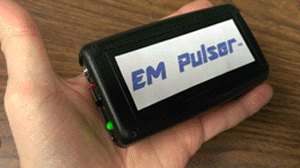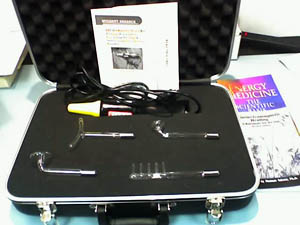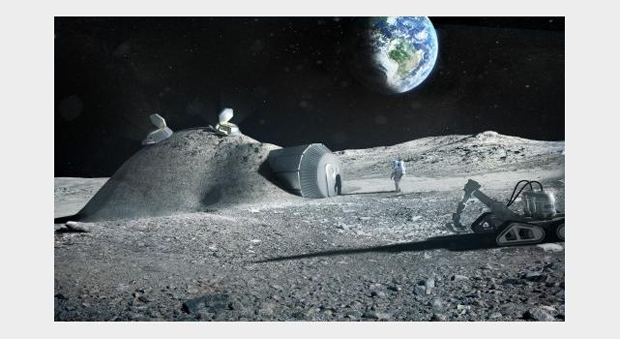|
|
|
Greetings!
News
Brief: the new EM Pulser is now selling in quantity to new
distributors throughout the country every week. We can't seem to keep
them in stock. Try one out today! www.BioenergyDevice.org
We at IRI
receive lots of info that seems to relate to future energy and try to
be very selective about what to include in the reprint section below.
Some of the runner-ups include "Deep-sea warming slows down global
warming" which explains some of the recent cool
spells and "Putting the heat on Mother Nature"
which reports the end of a Little Ice Age geologically. I find that
any updates help us to gauge the urgency of the global need for
future energy.
Now for the
amazing collection of three (3) space stories in this FE eNews, we
look at Story #1 for our future XS-1 "space rental
car" thanks to Northrop and DARPA, and Story #2 for where the
space planes and rental cars will launch from in the UK, and
Story #3 for a new place to go besides the International Space
Station when these vehicles go online in the next couple years...all
of which is very exciting. We look forward to the future they will
bring as long as the cost starts to go down as the popularity of
space travel grows.
Now more down
to earth is how to power some of the great bioelectronics that are
emerging for lots of applications. Our Story #4 follows the
development of wireless power suited for medical implants. IRI
hopes that the epidemiological studies also follow to ensure
that any long-term exposure meets established safety
standards.
Next, we
welcome any cheap, portable, and very useful solar sticker to turn
any surface into a power source and yes, it is emerging with our
Story #5.
Lastly, what
do we do with all of that CO2 we humans are pumping into the
atmosphere at billions of tons per year? We can now thank a Princeton
student for coming up with such good ideas that it turned into the
Liquid Light company in our story #6.
Have a great
weekend,
Thomas
Valone, PhD, PE.
Editor
|
|
|


EM
Pulser
Our
best selling device

PREMIER
Jr.
|
|
|
1) Northrop Grumman's Space Plane Revealed
|
By Mike Wall, Senior Writer | August
22, 2014 04:12pm ET
http://www.space.com/26904-xs1-military-space-plane-northrop-grumman.html?cmpid=558130
The world is starting to get a
better idea of what the U.S. proposed new space plane
might look like.
This week, aerospace firm Northrop
Grumman released artwork depicting its conception of the XS1 space plane, which
it's designing under a $3.9 million contract from the U.S. Defense Advanced Research
Projects Agency (DARPA)

Northrop Grumman is one of three companies competing for
the right to build the unmanned XS-1, which is short for "Experimental Spaceplane."
The other two are Boeing and Masten Space Systems, both of which also
won yearlong "Phase 1" initial design contracts in July.
DARPA wants the XS-1 to make
spaceflight much more routine and affordable. The reusable vehicle
should be able to fly 10 times in a 10-day span and launch 3,000- to
5,000-lb. (1,361 to 2,268 kilograms) payloads to orbit for less than
$5 million per flight, officials have said.
XS-1 will probably feature a
reusable first stage and one or more expendable upper stages. The
first stage will fly to suborbital space at hypersonic speeds, then
return to Earth to be used again; the upper stages will deploy
payloads to orbit.
Northrop Grumman is teaming with
other aerospace companies on its design, tapping Scaled Composites to
head manufacture-and-assembly work and Virgin Galactic to lead XS-1
operation.
"Our team is uniquely
qualified to meet DARPA's XS-1 operational system goals, having built
and transitioned many developmental systems to operational use,
including our current work on the world's only commercial spaceline,
Virgin Galactic's SpaceShipTwo," Doug Young, vice president for
missile defense and advanced missions at Northrop Grumman Aerospace
Systems, said in a statement.
"We plan to bundle proven
technologies into our concept that we developed during related
projects for DARPA, NASA and the Research Laboratory,
giving the government maximum return on those ," he added.
Northrop Grumman is not alone in
reaching out to other firms for assistance in developing an XS-1
design. Masten is working with XCOR Aerospace, and Boeing is teaming
with Jeff Bezos' secretive firm Blue Origin.
DARPA expects to hold a Phase 2
competition next year to see which company makes it to the
flight-test stage of XS-1 development. (The agency only has
enough for one XS-1 contractor in the end.) Officials
currently envision that the first orbital mission of XS-1 will take
place in 2018.
|
2) UK to
Launch Commercial Spaceport by 2018
|
By Rob Coppinger, Space.com Contributor |
August 06, 2014 12:58pm ET
http://www.space.com/26749-uk-spaceport-commercial-space-plane.html?cmpid=558125
The U.K.
government is laying the groundwork for its first spaceport in
anticipation of a growing space tourism demand and a growing space
plane industry by 2030, according to a new timetable. Government
officials also envision orbital launches from that country within the
next 15 years.
According to the
new timetable, unveiled at the Farnborough
International. Airshow last month, the U.K. is planning to
build $85.5 million spaceport (50 million British pounds) and
anticipates a space tourism market
worth $65 million each year, as well as a space plane industry worth
$33.9 billion (20 billion pounds) by 2030.

The timetable
lays out a number of other specific dates: The spaceport could be
operational from 2016; the first suborbital flight would occur in
2018; the first sub-orbital space plane satellite launch from the
spaceport would take place in 2020; rocket engine testing for the
orbital space plane would occur in 2026, and that space plane would
be operational four years later.
U.K. Space
Agency Director General David Parker published the timetable at the
Farnborough International Airshow's Space Day Conference on July 15.
He also signed a memorandum of cooperation for space plane operations
with the U.S. Federal Aviation Administration (FAA) Associate
Administrator for Commercial Space Transportation George Nield, and
announced that Lockheed Martin will open a space
technology office in the English town of Harwell in
Oxfordshire.
Choosing a spaceport site
From now until
October this year, the U.K. Space Agency is undertaking a public
consultation about possible spaceport sites. Selection of a site
could take place before the end of 2016. The U.K. Civil Aviation
Authority (CAA) has identified eight sites across the United Kingdom's
nations of England, Scotland and Wales after 18 months of work. Six
of the sites are in Scotland, one is in Wales, and the one site in
England is on the country's southern coast, at Newquay Cornwall
Airport. Newquay is known in the United Kingdom for its surfing.
Andrew Nelson,
chief operating officer and vice president of business
development of Mojave, California-based space plane developer XCOR Aerospace, spoke
to Space.com at the Airshow about his company's interest in one
proposed site, Newquay. "Newquay is sort of interesting. It
points right out to the water. You're not flying over anything under
rocket power, which is nice." U.K. government officials
interviewed Nelson and other XCOR staff in June and early July 2013
at Mojave, spending two to three days there, Nelson said. The
officials also spoke to Virgin Galactic and Stu Witt, manager of the
Mojave Air and Space Port. [See an animation of the
Lynx in flight]
Previously,
potential users, such as Virgin Galactic, have favored Lossiemouth,
in Scotland. A 2009 report into spaceport candidate locations for the
U.K. Space Agency's predecessor, the British National Space Centre
(BNSC), found Lossiemouth to be the best site. Located in northern
Scotland, Lossiemouth is on the coast of the North Sea and has a
Royal Air Force base with a runway suitable for the types of launch
systems used by Sir Richard Branson's Virgin Galactic. That
company had already identified Lossiemouth as a possible U.K.
spaceport; in 2009, then Virgin Galactic President Will Whitehorn,
who was born in Scotland, spoke of his hope for a spaceport in the
location. The 2009 report did not set a date for constructing such a
facility.
A September
referendum on whether Scotland will remain a part of the United
Kingdom could complicate that choice for a 2018 spaceport,
however. If the yes vote in the referendum wins, Scotland could be an
independent country by 2018. A poll last week by ICM Research found
that 34 percent of Scottish voters would vote yes for independence,
45 percent would vote no and the remainder don't know.
The $85.5
million spaceport price tag comes from a science report published in
April by the U.K. Space Agency's parent body, the Government's
Department for Innovations and Skills (BIS). Parker told
Space.com that the cost estimate for the spaceport was an informed
guess. The BIS report also proposed a national space propulsion
facility that would cost about $10 million, or 6 million British
pounds.
The eight
spaceport sites and the detailed timetable published at the Farnborough Space Day
Conference come from the CAA's report, "U.K. Government
Review of Commercial Space Plane Certification and Operations,"
released this month. The report's timetable also envisages a number
of other goals: wet lease agreements by 2016 under common FAA and CAA
rules, pan-European space plane legislation regulation developed from
2016 and a vertical rocket launch site to be identified in northern
Scotland by 2020. And from 2020 to 2030, the CAA expects space planes
to be certified and no longer experimental, space plane operations to
start from additional sites in the United Kingdom, and most U.K.
spaceflights to use U.K. crews.
Whichever
spaceport is selected, Xcor and Virgin Galactic are the most likely
space plane developers to be in a position to launch from the
spaceport in 2018. The report also identifies several other spaceport
users: Airbus' Spaceplane, Bristol Spaceplanes' Spacecab, Orbital
Sciences' Pegasus rocket, Stratolaunch Systems' air-launched system
and Swiss Space Systems' Sub-Orbital Aircraft Reusable vehicle. [See photos of Virgin
Galactic's SpaceShipTwo]
Market research
by the U.K. small satellite maker Surrey Satellite Technology (SSTL)
calculated that the first year of space tourism operations would have
120 tourists with 150 tourists in year three. This assumed Xcor and
Virgin Galactic were operating in the United Kingdom. It would mean
revenue of $24 million by that year three, SSTL said. By year 10,
SSTL expects more than 400 tourists and annual revenues of $65
million.
Despite the
United Kingdom-focused timeline, Xcor and Virgin employ U.S. rocket
technology. The use of that technology outside of the United States
is regulated under export controls. Called International Traffic in
Arms Regulations or ITAR, it is the first obstacle to operating
rocket-powered space planes outside of the United States. The U.K.
Ministry of Defence has made progress on understanding this issue,
said U.K. Space Agency Director for Growth, and European
Union Programs Catherine Mealing-Jones, speaking at the Space Day
Conference.
Another
regulatory issue is the legal process to allow the space planes to fly
in U.K. airspace up to space. Under the Outer Space Treaty that
the United Kingdom signed, governments are responsible for launches
by their citizens. The U.K. Space Agency is the regulatory authority
for the U.K. Outer Space Act 1986, and discharges the country's
obligations under the four outer-space-related treaties. However,
Parker told Space.com that because suborbital space planes do not go
into orbit, the treaty does not apply. Instead, Parker's agency plans
to treat space planes as experimental aircraft under U.K. and
European aviation law. Passengers would have to agree to something
like the informed consent concept that the FAA is using.
However, the
report also states that the United Kingdom should not adopt the FAA
approach and instead should remain in step with "future
[European Union] developments." The European Union (EU) could
have space plane legislation within the next five years. The European
Aviation Safety Agency (EASA) is an EU agency, and the United Kingdom
is a member state of EASA. The EASA official drawing up the space
plane legislation, Jean-Bruno Marciacq, told Space.com at the Space
Day Conference that the legislative proposals are ready to go the
European Commission's (EC) Department of Mobility and
Transport.
The delay has
been due to the EU's European Parliament elections, held every five
years.
back to table of contents
|
3) Lunar
Habitat Commission by European Space Agency
|
|
Foster
+ Partners designs 3D moon base Global architecture practice uses
latest rapid prototyping to imagine a lunar base for European Space
Agency

Architects are used to designing
buildings to withstand extreme conditions - earthquakes, sub-zero
temperatures, gale-force winds. But few flag up meteorites and gamma
radiation in the brief. Foster + Partners' recent feasibility
study for a lunar base had to take such a climate into account
though clearly the firm took this assignment in its stride.
"As a practice, we are used to
designing for extreme climates on Earth and exploiting the
environmental benefits of using local, sustainable materials,"
says Xavier De Kestelier at Foster + Partners' Specialist Modelling
Group, "Our lunar habitation follows a similar logic."
The practice was commissioned by
the European Space Agency to create a concept for a four-person
dwelling on the moon. But how do you get your construction materials
and builders up there?
The architects' solution was to
turn to 3-D printing. "Terrestrial 3D printing technology has
produced entire structures," points out Laurent Pambaguian, who
is leading the project for ESA. "Our industrial team
investigated if it could similarly be employed to build a lunar
habitat."
 Scott Hovland of
ESA's human spaceflight team explains the advantages of this
approach: "3D printing offers a potential means of facilitating
lunar settlement with reduced logistics from Earth. The new
possibilities this work opens up can then be considered by
international space agencies as part of the current development of a
common exploration strategy." Scott Hovland of
ESA's human spaceflight team explains the advantages of this
approach: "3D printing offers a potential means of facilitating
lunar settlement with reduced logistics from Earth. The new
possibilities this work opens up can then be considered by
international space agencies as part of the current development of a
common exploration strategy."
One part of the base would be taken
up there by rocket in a tubular module. Once up there, the module
would become the base's entrance, which would lead into an inflatable
dome. Inside the dome, a robot would operate the printer to print a
protective layer using locally-sourced lunar soil over the outside of
the dome. This would help protect those inside from your usual lunar
hazards of space radiation and micrometeoroids.
The company supplying the printer,
Monolite, is more au fait with creating sculptures than
extra-terrestrial dwellings. But again, it seems unfazed. Company
founder Enrico Dini explains the process:

"First, we needed to mix the
simulated lunar material with magnesium oxide. This turns it into
'paper' we can print with. Then for our structural 'ink' we apply a
binding salt which converts material to a stone-like solid."
Monolite's current printer builds at a rate of
around 2m per hour, meaning construction will be quite a slow
process. However its next-generation design will be up to 3.5m per
hour, so a whole building will be done and (moon) dusted within a
week. More innovative invention with a sustainable edge can be found
in Vitamin P2. For the lowdown on what
more innovative building technologies can help facilitate check out The Phaidon Atlas of 21st Century
Architecture.
|
4) Magnetic
Fields Power Implants
|
By Suzanne
Jacobs, Technology Review , August 21, 2014

Medical implants like pacemakers,
deep brain stimulators, and cochlear implants could someday be joined
by still more bioelectronic gadgets-devices that regulate insulin
levels, control appetite, lower blood sugar, or treat brain injuries
(see "Nerve-Stimulating Implant Could Lower
Blood Pressure").
But before we're all riddled with
electronics, researchers have to figure out how to power it all.
Pacemaker batteries are too clunky for tiny devices saddled up to
nerves, and existing wireless methods, such as those used for
cochlear implants, won't work with devices buried deep in the body.
That's where electrical engineer Ada Poon and her team at Stanford
University say they might be able to help. The group has developed a
new method of sending magnetic fields well below skin level to power
devices that would otherwise need batteries.
Wireless systems like the one used
in cochlear implants sit permanently on the skin and derive power
from electromagnetic induction, in which a current running through a
coil of wire generates a magnetic field that then induces a current
in a nearby device. The problem is that a field generated this way
decays exponentially with distance from the generating coil, so it
only works with devices close to the skin's surface.
Poon and her team found a way to
use electromagnetic induction through biological tissue without that
exponential decay. They call the technique midfield wireless powering
(as opposed to near-field, which refers to the exponentially decaying
radiation, and far-field, which refers to the kind of radiation
emitted from a cell tower).
The key, Poon says, is that instead
of using a coil of wire, they use a flat plate adorned with a
specially designed four-line pattern of conductive material. When
they send current through the plate, that pattern produces a magnetic
field capable of propagating through biological material without
decaying over a short distance. The plate would most likely sit on
the skin, providing constant power to an implant.
Morris Kesler, vice president of
research and development at WiTricity, a Massachusetts-based
company that develops wireless powering systems, says Poon's
technique would be particularly useful for powering tiny devices.
To test their new powering scheme,
the Stanford group implanted a pacemaker about the size of a grain of
rice in a rabbit and then powered the device using a plate about six
centimeters on a side. The setup worked with about 0.1 percent
efficiency-meaning that nearly all the energy sent from the
conductive material to the pacemaker was wasted. Nonetheless, Poon
says that is sufficient for this kind of low-power medical device. It
also met safety regulations limiting the amount of radiation
delivered to a given amount of tissue in humans.
In the future, Poon says, the group plans to develop
flexible versions of the plate that will be more comfortable against
skin. One of her graduate students is also designing plates that will
penetrate materials other than biological tissue.
Kip Ludwig, the program director for
neural engineering at the National Institute of Neurological
Disorders and Stroke at the National Institutes of Health, says
Poon's method is promising but years from any clinical application.
Still, there is so much promise in bioelectronics, he says, and the
powering issue needs to be addressed.
back to table of contents
|
5) Solar
Stickers Makes Any Surface into a Power Source
|
By Katherine Bourzac , MIT Technology
Review, 2014

Stanford professor Xiaolin Zheng
often works in the esoteric fringes of nanoscience, but she also
likes to find simple ways to fabricate complex materials that can be
put to use in practical applications like solar-fuel systems, solar cells,
and batteries. Last year she created solar cells in the form of
flexible stickers-only a 10th as thick as plastic wrap-that can be
applied to a window, a piece of paper, the back of a mobile phone, or
anything else you want. These solar cells produce just as much
electricity as rigid ones made of the same materials.
Zheng got the inspiration for this
invention from her father. One day when they were talking on the
phone-he in China, she in California-he said that it should be
possible to put solar cells on the walls of buildings, not just the
roof. And Zheng's daughter, like many kids, loves stickers.
All this was in the back of Zheng's
mind when she read a research paper about graphene, a novel type of
nanomaterial. The researchers grew the material on a layer of nickel
on top of a silicon wafer. When they put the whole thing in water,
the nickel separated from the surface, taking the graphene with it.
"I couldn't believe that soaking in water would do this,"
she says.
Zheng has demonstrated this
water-soaking approach as a way to peel off thin-film silicon solar
cells grown on a rigid substrate. It turns out the phenomenon-called
water-assisted subcritical debonding-had been known since the 1960s,
but no one before had tried using it to make flexible electronics.
She hopes the technology will be scaled up beyond the
one-square-centimeter devices she's made so far, so that the sides of
buildings can one day be papered with solar cells as her father
suggested.
In this interview backstage at EmTech, 2013 Innovator
Under 35 Xiaolin Zheng discusses making solar cells more broadly
applicable.
Watch: Xiaolin Zheng on stage
at EmTech
back to table of contents
|
6) Converting
CO2 into Something Useful
|
By Stephen Hall, MIT Tech Review July
2014
http://www.technologyreview.com/lists/innovators-under-35/2014/inventor/emily-cole/
As the chief science officer of a
startup called Liquid Light, Emily Cole is
attempting to accomplish something that has long thwarted chemists:
finding an economical and practical way to turn carbon dioxide, the
chief culprit in greenhouse warming, into useful chemicals.

The idea that could make this
possible came from a visit to the Princeton University lab of Andrew
Bocarsly. Back in 1994, Bocarsly had published an intriguing but
largely ignored paper reporting a way to convert carbon dioxide into
methanol without using a lot of energy. Bocarsly couldn't get funding
to pursue the research, and the work sat on the shelf until he
mentioned it to Cole. She was fascinated and decided to join his lab
as a graduate student.
Cole kept tinkering with different
catalysts and conditions, increasing the yields of the reactions and
learning how to produce other valuable chemicals. The researchers
have gone on to show they can convert carbon dioxide into
isopropanol, acetone, and more than 30 other chemicals. Moreover,
they have shown that light can be used to drive the reactions.
In 2009, Cole and Bocarsly
cofounded Liquid Light in Monmouth Junction, New Jersey. The company
is working to scale up the conversion process and hopes to market
ethylene glycol, a chemical widely used to make plastics, as soon as
2017.
|
About Integrity Research Institute
Future Energy eNews is
provided as a public service from Integrity Research Institute,
a Non-Profit dedicated to educating the public on eco-friendly
emerging energy technologies.
FREE copy
of the 30 minute DVD "Progress in Future Energy" is
available by sending an email with
"Free DVD" in subject and mailing address in
body.
Your generous support is
welcome by making a tax deductible donation on
our secure website
|
|
|
|
|
|
![]()





















